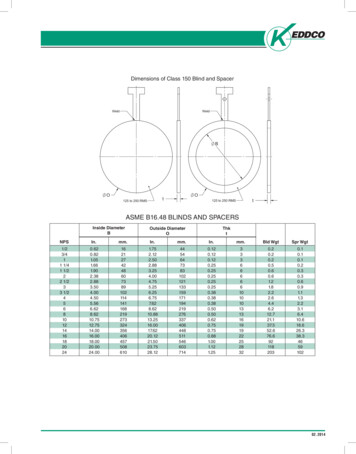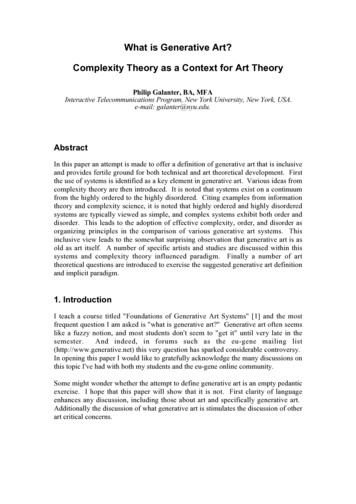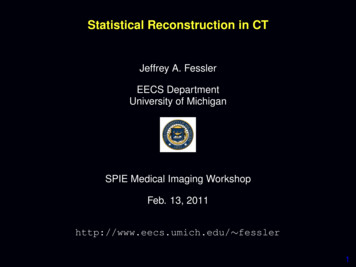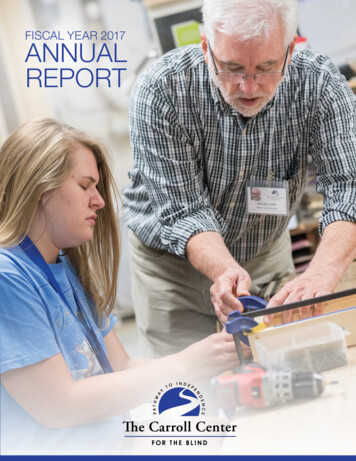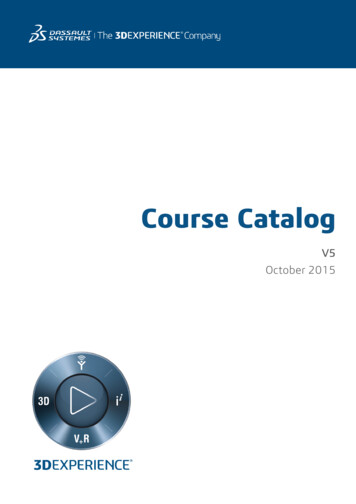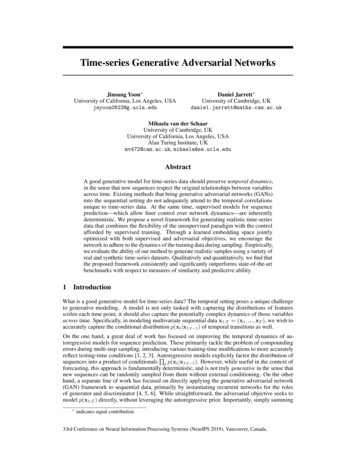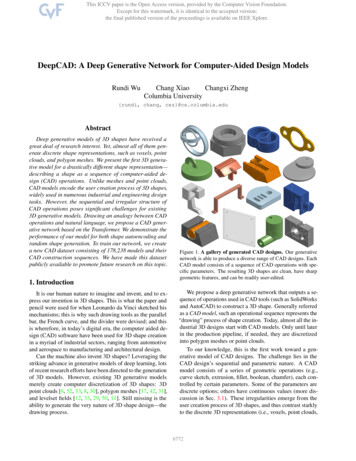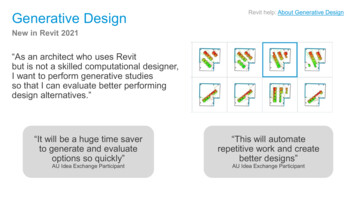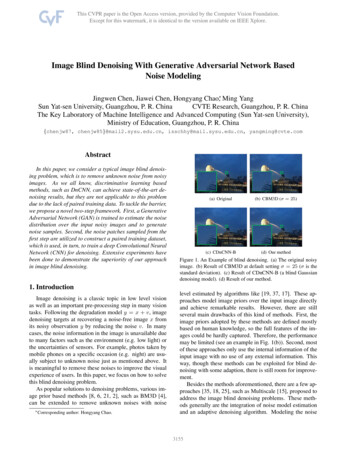
Transcription
Image Blind Denoising With Generative Adversarial Network BasedNoise ModelingJingwen Chen, Jiawei Chen, Hongyang Chao , Ming YangSun Yat-sen University, Guangzhou, P. R. ChinaCVTE Research, Guangzhou, P. R. ChinaThe Key Laboratory of Machine Intelligence and Advanced Computing (Sun Yat-sen University),Ministry of Education, Guangzhou, P. R. China{chenjw87, chenjw85}@mail2.sysu.edu.cn, isschhy@mail.sysu.edu.cn, yangming@cvte.comAbstractIn this paper, we consider a typical image blind denoising problem, which is to remove unknown noise from noisyimages. As we all know, discriminative learning basedmethods, such as DnCNN, can achieve state-of-the-art denoising results, but they are not applicable to this problemdue to the lack of paired training data. To tackle the barrier,we propose a novel two-step framework. First, a GenerativeAdversarial Network (GAN) is trained to estimate the noisedistribution over the input noisy images and to generatenoise samples. Second, the noise patches sampled from thefirst step are utilized to construct a paired training dataset,which is used, in turn, to train a deep Convolutional NeuralNetwork (CNN) for denoising. Extensive experiments havebeen done to demonstrate the superiority of our approachin image blind denoising.(a) Original(b) CBM3D (σ 25)(c) CDnCNN-B(d) Our methodFigure 1. An Example of blind denoising. (a) The original noisyimage. (b) Result of CBM3D at default setting σ 25 (σ is thestandard deviation). (c) Result of CDnCNN-B (a blind Gaussiandenoising model). (d) Result of our method.1. IntroductionImage denoising is a classic topic in low level visionas well as an important pre-processing step in many visiontasks. Following the degradation model y x v, imagedenoising targets at recovering a noise-free image x fromits noisy observation y by reducing the noise v. In manycases, the noise information in the image is unavailable dueto many factors such as the environment (e.g. low light) orthe uncertainties of sensors. For example, photos taken bymobile phones on a specific occasion (e.g. night) are usually subject to unknown noise just as mentioned above. Itis meaningful to remove these noises to improve the visualexperience of users. In this paper, we focus on how to solvethis blind denoising problem.As popular solutions to denoising problems, various image prior based methods [8, 6, 21, 2], such as BM3D [4],can be extended to remove unknown noises with noise Correspondingauthor: Hongyang Chao.level estimated by algorithms like [19, 37, 17]. These approaches model image priors over the input image directlyand achieve remarkable results. However, there are stillseveral main drawbacks of this kind of methods. First, theimage priors adopted by these methods are defined mostlybased on human knowledge, so the full features of the images could be hardly captured. Therefore, the performancemay be limited (see an example in Fig. 1(b)). Second, mostof these approaches only use the internal information of theinput image with no use of any external information. Thisway, though these methods can be exploited for blind denoising with some adaption, there is still room for improvement.Besides the methods aforementioned, there are a few approaches [35, 18, 25], such as Multiscale [15], proposed toaddress the image blind denoising problems. These methods generally are the integration of noise model estimationand an adaptive denoising algorithm. Modeling the noise3155
plays a central role in denoising. Similar to the prior baseddenoising methods, most of these approaches only utilizethe internal information of a single input image. Moreover,the model of noise is generally defined explicitly, whichmay also limit their performance.If blind denoising is left aside, there is another typeof denoising methods based on discriminative learningworth to mention. These approaches [3, 30, 31], especially those based on Convolutional Neural Network (CNN)[33, 16, 32], train a deep denoising network with pairedtraining datasets and learn the underlying noise model implicitly, which obtains remarkable results. For the denoising problem of known noise like Gaussian noise, it is possible to form paired training data and leverage these methods to achieve state-of-the-art performance. Particularly,CNNs based approaches don’t have to depend on humanknowledge of image priors. They could fully exploit thegreat capability of the network architecture to learn fromdata, which breaks through the limitations of prior basedmethods and further improves the performance. In general,on the premise that the paired training dataset is available,this kind of approaches outperforms the previous methods.However, such a paired training dataset would be unavailable or hard to derive in reality [24]. Generally, what wecan only get is noisy images with the noise information unknown. In addition, real noises are more complex so thatusing the existing models, which were trained for denoising known noises (e.g. Gaussian noise), to address realisticproblems couldn’t achieve good results (see an example inFig. 1(c)). As such, lacking paired training datasets, theseapproaches might not be exploited to deal with the blinddenoising problems directly.According to the above analysis, a seductive idea comesto our mind: if it is possible to construct paired trainingdata only from the given noisy images, the image blind denoising problem would be better solved by leveraging theadvantages of discriminative learning and CNNs. Obviously, one solution to build such a training dataset is tomodel the noise distribution over noisy images, and thento sample noise data. As a typical approach, Gaussian Mixture Model (GMM) has been widely adopted in previousworks [35, 34, 23] for noise modeling. Following their wisdom, GMM was first utilized in our experiments to modelthe noise over the input realistic noisy images. However,the noise samples generated from the learned model are notvery similar to the observed noise. Thus, a more suitablenoise modeling approach is needed under the consideredscenario.The emergence of Generative Adversarial Network(GAN) shows the possibility to us [7]. GAN is a frameworkfor estimating generative models. This framework consistsof a generative network and a discriminative network. Generally, the generative network is trained to generate sampleswhich are hard to be distinguished from real data, whilethe discriminative network is trained to determine whethera sample is from real data or the generative network. GANleverages the great capability of CNNs to learn the latentnoise model implicitly, which might loosen the dependencyon priors. A lot of practices [13, 28, 27] have proved thatGANs could learn complex distribution. If GANs couldbe exploited to build a paired training dataset, the problemabove would be solved. That is actually the main purposeof this paper. However, it is not trivial to realize this goal.Once we have images with unknown noise, an intuitive wayto build paired training datasets is to train the generativenetwork of GAN to learn the mapping from a clean imageto an image with similar noise. Nonetheless, we found thatit doesn’t work this way. The generative network can betrained to learn the distribution of real noisy images andgenerate images with similar noise, but currently there areno mechanisms to ensure the content of the original imagenot to be changed. In order to solve this problem, an alternative solution is proposed: training the generative network toproduce the similar kind of noises rather than noisy images.According to the previous analysis, we propose a noveltwo-step framework in this paper. First, a GAN is trainedto estimate the noise distribution over the input noisy images and to generate noise samples. Second, the noisepatches sampled from the first step are utilized to constructa paired training dataset, which is used, in turn, to traina deep CNN for denoising the given noisy images. Details will be demonstrated in section 3. Our approach overcomes the aforementioned drawbacks of previous methodsand solves the key issue of discriminative learning baseddenoising methods. Extensive experiments demonstrate thesuperiority of our approach in image blind denoising.The major contributions of this paper are at least twofolds: (1) We propose a GAN-CNN based framework to address the problem of image blind denoising, which achievesimpressive results. When dealing with unknown noise,GAN is utilized to solve the key issue of building pairedtraining datasets, and then CNN is employed for denoising. (2) To the best of our knowledge, we are the first toexplore the potential of GAN in noise modeling. The ability of GAN to estimate complex distributions is exploitedto learn noise distributions implicitly, overcoming the difficulty of explicitly defining the model of unknown noise.2. Related WorkAs the purpose of this paper is to develop an advanceddenoising algorithm with GAN based noise modeling in order to improve the blind denoising performance, we brieflypresent three kinds of related denoising methods first: image prior based methods, noise modeling based blind denoising algorithms as well as discriminative learning basedapproaches. Then, the GAN is introduced subsequently.3156
2.1. Image Prior Based Denoising MethodsMost of denoising methods are based on image priors,such as BM3D [4], NSCR [6], and WNNM [8]. Most thesemethods do not require training data because they model theimage prior over the noisy image directly, and thus can beemployed to solve the denoising problem of unknown noise.One of the classic methods is BM3D, which is a benchmark in image denoising. BM3D achieves impressive results by combining the non-local self-similarity model andsparse model. More precisely, similar 2-D image fragmentsare grouped into 3-D data arrays which are processed bycollaborative filtering subsequently. After that, jointly filtered grouped image blocks are obtained and returned totheir original positions in the image. Nonetheless, there arestill some problems of BM3D and most image prior basedmethods. First, the image priors adopted are defined mostlybased on human knowledge and may limit the denoisingperformance. In addition, when modeling the image priors, most methods only utilize internal information of theinput image while the external information from other images, such as images taken under the same condition or froma large dataset, is underused. If we could make full use ofall the information and leverage the benefits of mature discriminative learning based methods as well, the denoisingperformance may be further boosted.2.2. Noise Modeling Based Blind Denoising MethodsTo our best knowledge, only a few approaches [35, 15,18, 26] have been proposed to address image blind denoising problems. As aforementioned, these methods arethe conjunction of noise modeling and an adaptive denoising algorithm generally. Multiscale [15] is an adaption ofthe Non-local Bayes approach [14]which assumes the noisemodel of each patch and its nearby patches to be zero-meancorrelated Gaussian distributed. NMBD [35] proposes tomodel image noise with mixture of Gaussian (MoG) anddevelop a Low-rank MoG filter to recover the clean images.These methods only utilize the internal information of a single input image and explicitly define the noise model, whichmay limit the capability of noise modeling and further affectthe denoising performance. If more external information,better noise modeling methods as well as advantages of discriminative learning could be exploited, the blind denoisingproblem would be better addressed.2.3. Discriminative Learning Based DenoisingMethodsTo date, discriminative learning based approaches [33,32, 16] have achieved significant success in image denoising. These methods utilize the great capability of deepnetwork and external information from large datasets toachieve impressive results. In particular, DnCNN [32] trainsa very deep CNN with residual learning and batch normalization strategies and achieves state-of-the-art results inGaussian denoising. In addition, for blind Gaussian denoising, DnCNN trains a single network by using noisy images of different levels. Although these methods achievehigh denoising quality, they cannot work in the absence ofpaired training data, which is often the case in reality. Ifthe problem could be solved, this kind of methods could beexploited to better solve image blind denoising problems.2.4. Generative Adversarial Network (GAN)Recently, Generative Adversarial Network (GAN) hasattracted extraordinary attention. GAN [7] has been proposed to estimate the generative model, which sidestepssome difficulties of using deep generative models, such asapproximating intractable probabilistic computations. Ingeneral, GAN consists of a generative network and a discriminative network. The discriminative network is trainedto determine whether a sample is from real data or the generative network. At the meantime, the generative networkis trained to produce samples good enough to fool the discriminative network. During the training, the two networkscompete with each other and finally the distribution whichthe generative network captures is as close as possible to thedistribution of real data. More applications of GANs can befound in works [13, 28, 36, 5]. In these works, GANs showthe potential to learn complex distributions. However, it iswell known that training a GAN is tricky and unstable. DCGAN [27] has provided some useful guidelines for building and training GANs. WGAN [1, 9] further improves thetraining of GANs by overcoming the difficulties of maintaining the training balance between the generative networkand the discriminative model and designing the network architecture. What’s more, high quality samples can be generated in WGANs. If GANs could be employed to generate paired training data for blind denoising problems, aforementioned discriminative learning based methods will beeasily exploited to solve the problem.3. GAN-CNN Based Blind Denoiser (GCBD)For the image blind denoising problem, the basic idea ofour approach is to construct paired training data from thegiven noisy images, and then to train a deep denoising network for removing the noise from these given noisy images.The key issue is to build the dataset and Generative Adversarial Network (GAN) is adopted to solve this problem. Aswe describe in section 1, it is difficult to train the generative network generally to learn the mapping from a cleanimage to an image with similar noise to the given data. Toease this problem, a generative network would be trainedto produce noise rather than noisy images. To simplify thisproblem, we assume the images dealt with having the samekind of unknown zero-mean noise [35, 20] which includes3157
Figure 2. An overview of the proposed GCBD framework. Givenunpaired data, approximate noise blocks extracted from noisyimages are exploited to train a Generative Adversarial Network(GAN) for noise modeling and sampling. A large number of noiseblocks are sampled from the trained GAN model. Then, both extracted and generated noise blocks are combined with clean images to obtain paired training data which is used to train a deepConvolutional Neural Network (CNN) for denoising the inputnoisy images.a wide range of noises. An overview of the proposed framework is illustrated in Fig. 2. The following subsections areorganized according to the steps mentioned above.3.1. Noise ModelingBefore building the paired training dataset, approximatenoise blocks need to be extracted from the given noisy images. Then, these blocks are used to better train the GANfor noise modeling and noise data generation.3.1.1Figure 3. The network architecture of the Generative AdversarialNetwork. The x̃ is a noise block generated by the generative network, and the x is a noise block extracted from noisy images. Thefilter number of the generative network from the second to the lastunit is 256, 128, 64, and is equal to the output channel numberrespectively. The filter number of the discriminative network fromthe first to the fourth unit is 64, 128, 256, and 512 respectively.patch is determined by the differences of mean and variance between pi and qij for each j. More precisely, twoconstraints are defined first asNoise Block ExtractionThis is an important step to correctly train a GAN to modelthe unknown noises, since the noise distribution would bebetter estimated from noise-dominant data. To reduce theimpact of the original background, a set of approximatenoise blocks (or patches), say V, need to be extracted firstfrom the parts with weak background in the given noisy images. This way, the noise distribution becomes the main objective for the GAN to learn, which might make the GANmodel more accurate. Under the assumption that the expectation of the noise distribution is zero, an approximatenoise patch can be obtained by subtracting the mean of arelatively smooth patch in noisy images. The smooth patchwe discuss here refers to the region where the internal partsare very similar.Based on the discussion above, we propose a fast smoothpatch search algorithm. Let pi and qij denote a global patchwith size d d and a local patch of pi with size h h respectively. Each pi is obtained by scanning the whole noisyimage with stride sg and each qij is obtained by scanningpi with stride sl . In the algorithm, whether pi is a smooth M ean(qij ) M ean(pi ) µ · M ean(pi ),(1) V ar(qij ) V ar(pi ) γ · V ar(pi ),(2)andwhere M ean( ) and V ar( ) calculate the mean and thevariance respectively, and µ, γ (0, 1). If for each j, thetwo constraints are satisfied, pi will be regarded as a smoothpatch and added to the set S.When S {s1 , s2 , · · · , st } is obtained by applying thealgorithm to all noisy images, the set of approximate noiseblocks V {v1 , v2 , · · · , vt } can be derived by vi si M ean(si ). Nowadays, the devices that we use generallyproduce high resolution images. There are a large numberof eligible smooth areas in these images, such as the sky,walls and so on. Thus, sufficient smooth patches can befound in limited images, which means enough noise blockscan be extracted to train a GAN in the next step.3.1.2Noise Modeling with GANThe patterns and quantity of noise blocks extracted in thelast subsection are limited, especially when input noisy im-3158
ages are not enough. The results of training a deep CNNonly with these blocks are not so satisfying (see discussionin Section 4.5). To boost the denoising performance, onesolution is to model the noise distribution over these extracted blocks V, and then to generate more noise data (anynumber of samples with more diversity) for the training ofCNN. Therefore, in this subsection, the GAN will be introduced as a promising choice.The basic idea of GAN has been briefly mentionedin section 1 and 2. As a framework to estimate generative models, GAN has the capability to learn complex distributions. What’s more, GANs can be trained byback-propagation algorithm and produce noise samples byforward-propagation only without involving another component. In the proposed method, a GAN is adopted to estimate the noise distribution over a set of approximate noiseblocks V. Since WGAN [1] may improve the training ofGANs and generate high quality samples as described previously in the section of related works. Therefore, in ourexperiments, WGAN-GP [9], which is an improved versionof WGAN, is adopted to learn the noise distribution. Theobjective function for our task isFigure 4. The network architecture of the Convolutional NeuralNetwork. The input is a noisy image yi , and the output is thedifference R(yi ; Θ) between the input and the latent clean image.The predicted clean image can be obtained by yi - R(yi ; Θ). Thefilter number of the last unit is equal to the output channel number.Each of the other units contains 64 filters.training of the denoising network. In each epoch, the combinations of xj and vk′ are changed and a new dataset{X, Y′ } is obtained, which leads to further data augmenLGAN E [D(x̃)] E [D(x)] λ E [(k x̂ D(x̂) k2 1)2 ],tation.x Prx̃ Pgx̂ Px̂(3)Once the paired training dataset is built, a CNN can bewhere Pr is the distribution over V, Pg is the generator distrained for denoising finally. We adopt the similar networktruibution, Px̂ is defined as a distribution sampling uniformstructure to DnCNN [32] in our experiments. The CNNlly along straight lines between pairs of points sampled fromis regarded as a single residual unit to predict the residualPr and Pg . See more details in [9].image, i.e., the difference between the input noisy imageWe adopt the similar network to DCGAN [27]. The netand the latent clean image. The objective function to bework structure is illustrated in Fig. 3. More details can beminimized is defined asfound in [27]. The trained GAN model is used to generate noise samples for augmenting V and finally a larger setN′1 XV′ {v1′ , v2′ , · · · , vw} is obtained.LCN N (Θ) k R(yi ; Θ) (yi xi ) k2 ,(4)2N3.2. Denoising with Deep CNNMany previous works [33, 32, 16] have proposed to solvedenoising problems by training a CNN with large datasetsand achieved impressive results. As described in Section1 and 2, CNNs own the great capability of the network architecture to learn the latent noise model from the pairedtraining dataset implicitly, which loosens the dependencyon human knowledge of image priors. Thus, a CNN is utilized in our framework for denoising.In order to train the CNN, a paired training dataset needto be built first. Given the set V′ obtained from the section 3.1.2, another set of clean images are divided intosmall patches of size d d which form the set X {x1 , x2 , · · · , xe }. Noise blocks in V′ are randomly addedto patches in X to obtain Y {y1 , y2 , · · · , yf }, whereyl xj vk′ . The set X and Y form a paired trainingdataset {X, Y}. Actually, the dataset is built during theFi 1where Θ is the parameters of the network, N is the size oftraining data, yi is a noisy image, xi is the ground truth.Batch Normalization [12], ReLU [11] as well as residuallearning strategy [10] are also adopted to improve the training of the deep network.The network structure of the CNN, which consists of 17units, is illustrated in Fig. 4. Zero padding is adopted toensure the dimension of the input and output is consistent.4. ExperimentsIn this section, we evaluate the proposed GCBD methodon both synthetic and real-world data. Comparisons aremade among several representative approaches. Four partsof experiments are carried out: (1) to verify the accuracy ofnoise modeling with GAN, GCBD is compared with stateof-the-art denoising methods, especially a discriminative3159
(a) Noisy / 34.86(b) BM3D / 38.36(c) DnCNN-B / 38.12 (d) Multiscale / 35.18(e) GCBD / 40.30(f) Ground truthFigure 5. Comparison (PSNR/dB) on BSD68 in the evaluation of mixture noise denoising with s 25. Zoom in for better view.Table 1. The PSNR (dB) results of all the compared methods on BSD68 in synthetic noise denoising tasks.Gaussian NoiseModeMethodSettingσ 15σ .62ModeMethodSettings 15s .98BlindWNNMMultiscaleDnCNN-Bscale 1scale 231.3730.4829.7231.6128.8327.5826.7729.16Mixture NoiseBlindWNNMMultiscaleDnCNN-Bscale 1scale 241.0438.9937.9840.7537.6335.5435.1237.54learning based approach DnCNN [32], in Gaussian blinddenoising tasks (in section 4.2.1); (2) to show that GCBDcan deal with more complex noise besides Gaussian noise,the evaluation is conducted with mixture noise (in section4.2.2); (3) to examine the applicability to realistic problems,another evaluation is done with a public benchmark datasetand noisy images taken by a consumer device (in section4.3); (4) to give some discussion about the selection of noisemodeling method, noise samples are shown to illustrate thereason to choose GAN rather than other traditional methods, such as GMM. Extensive experiments demonstrate thesuperiority of GCBD in image blind denoising problems.4.1. Experimental SettingExperimental Data In the experiments on synthetic data,BSD68 [29] is utilized as the test set. In the experiments onreal-world data, the evaluations are conducted on a benchmark dataset Darmstadt Noise Dataset (DND) [24] and adataset NIGHT which includes 25 high resolution noisy images (about 3000 x 2000 pixels) taken by an ordinary mobile (iPhone 5s) at night. For the proposed GCBD, a set ofclean images (CLEAN1) is used to build the paired training dataset with noise data generated by GAN. In order tosimulate the condition where large images are processed inreality, noises are added to another set of high resolutionclean images (CLEAN2) to form the input noisy images forGCBD in the evaluation with synthetic data.Parameter Settings In the noise extraction step, parameters d, h, sg , sl , µ and γ are set to 64, 16, 32, 16, 0.1and 0.25 respectively. For noise modeling with GAN, weGCBD31.5929.15GCBD42.0039.87roughly follow the parameter settings in DCGAN [27]. Forthe CNN, it is trained with initial learning rate 0.001 andSGD optimizer for 50 epochs.Compared Methods The competing approaches includeBM3D [4], EPLL [38], NCSR [6], WNNM [8], Multiscale[15], DnCNN [32] and the proposed GCBD. Particularly,in order to reveal the limitations of discriminative learning based methods when dealing with blind denoising problems, the available blind model of DnCNN for Gaussiandenoising, denoted as DnCNN-B, is adopted in the evaluation. Specifically, DnCNN-B is trained with accurate Gaussian noise data from different levels (i.e. σ [0, 55]), whichachieves state-of-the-art blind Gaussian denoising results.4.2. Evaluation with Synthetic NoiseIn this part, different types of zero-mean synthetic noisedata are generated and added to BSD68 [29] to evaluate allthe competing methods. In this evaluation, except for Multiscale, DnCNN-B and GCBD, the other methods are provided with real noise levels (i.e. the standard deviation σ).Gaussian Noise It’s essential to conduct experiments ofblind Gaussian denoising since Gaussian noise is one of thewidely-studied noises. Table. 1 shows different results of allthe compared methods. Though no noise information is provided, GCBD still outperforms BM3D, EPLL, WNNM andMultiscale. Particularly, GCBD achieves comparable results with DnCNN-B. This is impressive because DnCNNB is trained with accurate data while GCBD is trained3160
with approximate data generated by GAN. This experimentdemonstrates the accuracy of noise modeling through usingGAN. More image examples can be found in the supplementary.Figure 6. Noise samples (scaled). Zoom in for better view.Mixture Noise Besides Gaussian noise, we further evaluate the performance of several methods in complex noisedenoising tasks. The mixture noise [34] adopted inthe experiments consists of 10% uniform noise [ s, s],20% Gaussian noise N (0, 1) and 70% Gaussian noiseN (0, 0.01). Table. 1 shows the quantitative results. Inthis task, GCBD also performs much better than BM3D,EPLL, WNNM and Multiscale, which further shows the superiority of GCBD in blind denoising problems. Particularly, DnCNN-B cannot work well because the paired training dataset is unavailable. On the contrary, the proposedGCBD exploits GAN to estimate the noise distribution ofnoisy images and addresses the problem of lack of trainingdata, which achieves remarkable denoising results. An example is shown in Fig. 5 and more examples can be foundin the supplementary.For the above cases (Gaussian and Mixture noises), theproposed method works well. Specifically, the deviation ofthe distribution learned by GAN over extracted noise blocksfrom the ground truth distribution is about 0.3% for meanand 1.5% for standard deviation on average.4.3. Evaluation with Real-World NoiseEvaluation on DND DND [24] is a novel benchmarkdataset which consists of realistic photos from 50 scenestaken by 4 consumer cameras. The competing methods areapplied and evaluated in sRGB space in this part. Table.2 shows the PSNR results. GCBD outperforms the othermethods by about 1 dB at least.of different methods on NIGHT-A. As we can see, compared with the other methods, GCBD does a pretty goodjob at retaining details, such as the spark of the light, whileremoving the noise. Fig. 8 shows the results on NIGHTB. GCBD also achieves the best result, which demonstratesthat GCBD can be employed to handle noisy images takenunder similar conditions.4.4. Selection of Noise Modeling MethodsAs described in section 1, as a typical modeling method,GMM has been widely utilized in previous works like[35, 34, 23] for noise modeling. However, due to the complexity of real-world noises, a traditional pixel-based GMMmay not handle realistic cases well as GAN under the considered scenario in this paper. Figure. 6 shows some noisesamples to illustrate the modeling capability for real noises.The sample generated by GAN is more similar to the observed real noises than that generated by GMM, whichcould demonstrate that GAN may deal with more complexnoises better than a simple pixel-based GMM. This is because the number of Gaussian models and the explicitlydefined model may limit the performance of GMM whileGAN leverages the great capability of CNN to learn thenoise model implicitly and to capture more features ofnoises without human knowledge of image priors. Thisway, GAN shows a potential in noise modeling problems.Furthermore, since the proposed framework is flexible, thenoise modeling component could be replaced with betterchoices in the future.4.5. Breakdown Performance Analysis of GCBDTable 2. The PSNR (dB) results of all the compared methods onDND in real-world noise denoising tasks.MethodPSNR valuation on NIGHT It is common that we get noisyimages at night. Thus, the e
which are hard to be distinguished from real data, while the discriminative network is trained to determine whether a sample is from real data or the generative network. GAN leverages the great capability of CNNs to learn the latent noise model implicitly, which might loosen the dependency on priors. A lot of practices [13, 28, 27] have proved that
